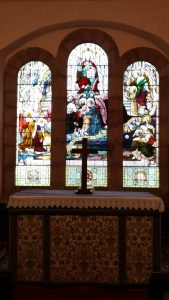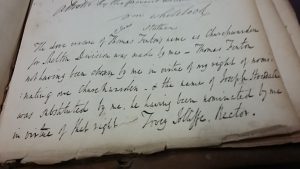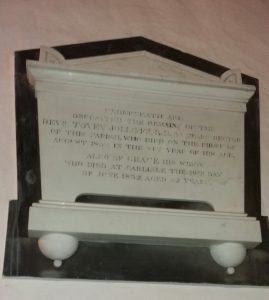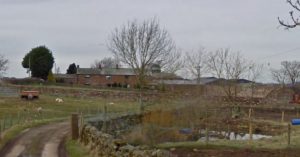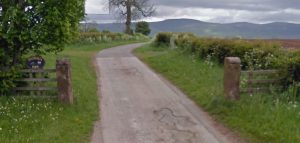Searching the apprentice records on the Staffordshire Names Index reveals the names of nine Elsmores from the Colwich area: Ann, Francis, George, James, John, Mary, Sarah, Thomas and William. Either it was common for people to pay a fine for not taking apprentices, or some of the Elsmores proved, on occasion, to be unsatisfactory in some way. Looking at the dates of the apprenticeships it seems that 1828 was a crucial year.
In 1828, aged 11, Ann Elsmore the daughter of Mary Hawthorn (late Elsmore) was apprenticed to housewifery to farmer James Astley of Hixon. The apprenticeship did not actually take place as another source notes that Astley paid £10 instead of taking an apprentice.
With his parents deceased, in 1832 Francis Elsmore, aged 10, was apprenticed to farmer Charles Haywood. However, the following year Haywood paid a £10 fine instead of taking Francis. On this occasion Francis’ age was given as 13. Instead, Francis (13) was apprenticed in husbandry to Samuel Buttery, another farmer on 13 July 1833. In 1835 Francis, (age given as 11 so it might be another Francis Elsmore) was apprenticed to farmer William Smith. In all instances, however, the sources note that Francis was an orphan.
George Elsmore was apprenticed to Thomas Aylsbury of Taft Farm in July 1823, but like Ann and Francis, by December his master had paid £10 instead of taking George. The following year George (11) was apprenticed to cordwainer John Elsmore.
Nine-year-old James Elsmore was apprenticed in husbandry to William Masters in 1823 on the same date that George had first been apprenticed.
In 1808 John Elsmore, the son of Thomas and Ann Elsmore of Bishton was apprenticed to farmers John and Thomas Bould of Hixon until he reached the age of 18.
Aged 10 Mary Elsmore (parents deceased) was apprenticed to John Day, a butcher in Great Haywood, in 1819.
In 1827 Sarah Elsmore, aged 10, was apprenticed in housewifery to Viscount Thomas William Anson of Shugborough. This arrangement does not seem to have worked out as in the following year Sarah (of Sitch Lane) became apprenticed in lace-making and housewifery to Henry Cox of Great Haywood (who is recorded as a baker so perhaps it was Henry’s wife who was to instruct Sarah). After this Sarah was to be assigned to James Elsmore.
Thomas Elsmore was apprenticed to James Trubshaw at his new house in Little Haywood in 1821.
William Elsmore (11) son of Sarah Elsmore of Hixon was apprenticed in husbandry initially to Henry Churchill, a schoolmaster. The apprenticeship them seems to have been transferred to Walter Yates, a farmer, of Coley.
Sources
SRO, D24/A/PO/2809, John Elsmore, 9 Apr. 1808
SRO, D24/A/PO/2721, John Elsmore, 9 Apr. 1808
SRO, D24/A/PV/1, John Elsmore, 9 Apr. 1808
SRO, D24/A/PV/1, Mary Elsmore, 27 Oct. 1819
SRO, D24/A/PO/2722, Mary Elsmore, 27 Oct. 1819
SRO, D24/A/PV/1, Thomas Elsmore, 15 Sep. 1821
SRO, D874/7/6/23, James Elsmore, 5 Jul. 1823
SRO, D24/A/PV/1, George Elsmore, 5 Jul. 1823
SRO, D874/7/6/27, George Elsmore, 18 Dec. 1824
SRO, D24/A/PO/2833, Sarah Elsmore, 4 Jul. 1827
SRO, D24/A/PV/1, Sarah Elsmore, 14 Aug. 1827
SRO, D24/A/PV/1, Sarah Elsmore, 16 Jul. 1828
SRO, D24/A/PO/2838, Sarah Elsmore, 16 Jul. 1828
SRO, D24/A/PO/2723, Sarah Elsmore, 2 Aug. 1828
SRO, D24/A/PO/2723, Ann Elsmore, 16 Jul. 1828
SRO, D24/A/PV/1, Ann Elsmore of Princes End, 16 Jul. 1828
SRO, D874/7/6/29, Ann Elsmore, 16 Jul. 1828
SRO, D24/A/PO/2723, William Elsmore, 16 Jul. 1828
SRO, D24/A/PO/2839, William Elsmore, 16 Jul. 1828
SRO, D24/A/PO/2840, William Elsmore, 16 Jul. 1828
SRO, D874/7/6/30, William Elsmore, 8 Nov. 1828
SRO, D24/A/PV/1, William Elsmore, 8 Nov. 1828
SRO, D24/A/PO/2723, William Elsmore, 8 Nov. 1828
SRO, D24/A/PO/2723, Francis Elsmore, 21 Jan. 1832
SRO, D24/A/PO/2723, Francis Elsmore, 11 Apr. 1833
SRO, D24/A/PO/2723, Francis Elsmore, 13 Jul. 1833
SRO, D874/7/6/34, Francis Elsmore, 13 Jul. 1833
SRO, D24/A/PO/2723, Francis Elsmore, 11 Jul. 1835
This is a work in progress, subject to change as new research in conducted
